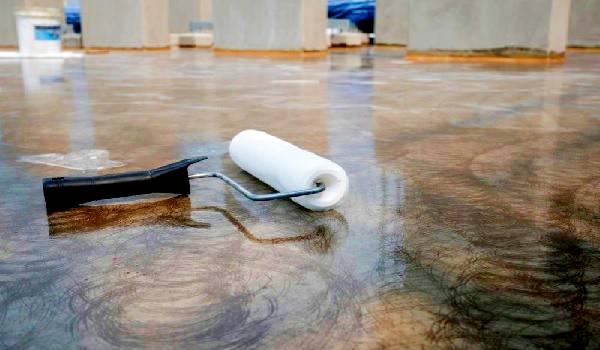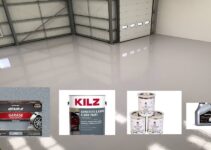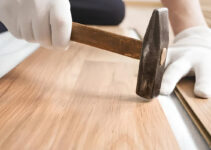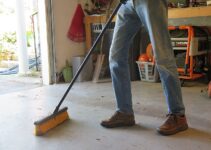Epoxy Garage Floor Problems
With years of experience dedicated to epoxy garage floors, I deeply appreciate the quest for a resilient and aesthetically pleasing surface capable of enduring the rigors of daily use.
Epoxy coatings have risen to prominence as the preferred option for countless individuals, delivering a seamless, lustrous, and low-maintenance finish.
Nevertheless, it is essential to acknowledge that even meticulously applied epoxy can confront challenges over time.
In this comprehensive guide, I aim to leverage my extensive experience to assist you in recognizing, mitigating, and resolving the prevalent issues that epoxy garage floors may confront.
What is an Epoxy Garage Floor?

Before delving into the common problems associated with epoxy garage floors, it’s essential to understand what epoxy flooring is.
Epoxy is a durable and long-lasting coating made by mixing epoxy resin with a hardener.
When applied to a concrete surface, it creates a strong, protective layer that not only enhances the appearance of the floor but also adds resistance to various forms of damage, such as chemicals, moisture, and abrasion.
Epoxy garage floors are a popular choice for homeowners and commercial spaces due to their durability and low maintenance requirements.
Common Epoxy Garage Floor Problems

- Peeling Epoxy Floor: One of the most prevalent issues with epoxy garage floors is peeling. This occurs when the epoxy coating detaches from the concrete substrate, leaving unsightly patches. The main causes of peeling are improper surface preparation and moisture issues.
- Cracking Epoxy Floor: Cracks in epoxy floors can develop over time due to factors like heavy vehicle traffic, temperature fluctuations, or an inadequate epoxy mixture.
- Bubbling Epoxy Floor: Bubbling appears as air or gas pockets trapped beneath the epoxy surface. It typically happens during the application process and is often caused by improper mixing or surface contaminants.
- Staining Epoxy Floor: Epoxy garage floors are susceptible to stains from oil, grease, and chemicals. These stains can mar the appearance of your floor if not cleaned promptly.
- Fading Epoxy Floor: Exposure to UV rays can cause epoxy floors to fade over time, leading to a dull appearance. This issue is more common in outdoor or sunlight-exposed garage floors.
- Chipping Epoxy Floor: Heavy impacts or sharp objects can lead to chipping or gouging in epoxy floors, compromising their aesthetics and functionality.
- Cloudy Epoxy Floor: Cloudiness or haziness in the epoxy coating can result from improper mixing, humidity during application, or low-quality epoxy products.
- Uneven Epoxy Floor: An uneven epoxy floor can occur if the coating isn’t applied consistently or if the underlying concrete surface is uneven.
- Discolored Epoxy Floor: Discoloration can happen due to exposure to certain chemicals or improper cleaning agents.
- Not Curing Epoxy Floor: Improper curing can result in epoxy floors remaining soft or tacky, making them susceptible to damage.
Read Also: Polyurea vs Epoxy
Causes of Epoxy Garage Floor Problems
Understanding the root causes of these problems is crucial to effectively prevent and address them. Here’s a breakdown of the common causes:
- Poor Surface Preparation: Insufficient surface preparation, including cleaning and profiling, can lead to adhesion issues, peeling, and staining.
- Moisture Issues: Moisture trapped in the concrete substrate or excessive humidity during application can cause various problems, such as bubbling, peeling, and curing issues.
- Inadequate Mixing: Improperly mixed epoxy can result in bubbling, cloudiness, and reduced durability.
- UV Exposure: Epoxy floors exposed to sunlight can fade over time if not adequately protected.
- Chemical Exposure: Harsh chemicals and solvents can cause discoloration, staining, and damage to epoxy floors.
- Heavy Traffic: Epoxy floors in high-traffic areas are more prone to cracking and chipping.
How to Prevent Epoxy Garage Floor Problems
Preventing epoxy garage floor problems starts with proper planning and execution. Here are some steps to ensure a long-lasting and trouble-free epoxy floor:
- Thorough Surface Preparation: Clean and prepare the concrete surface meticulously to ensure proper adhesion.
- Moisture Mitigation: Address moisture issues in the concrete substrate before applying epoxy. Use moisture barriers if necessary.
- Proper Mixing: Follow the manufacturer’s instructions for mixing epoxy resin and hardener precisely.
- UV Protection: Consider UV-resistant epoxy coatings or topcoats for outdoor or sun-exposed garage floors.
- Regular Maintenance: Promptly clean up spills and stains to prevent discoloration and damage.
- Protective Measures: Use mats, rugs, or parking mats in high-traffic areas to reduce wear and tear.
How to Fix Epoxy Garage Floor Problems
If you’ve already encountered epoxy garage floor problems, don’t worry; many issues can be remedied. Here are some common solutions:
- Peeling and Cracking: Remove the affected area, re-prepare the surface, and reapply epoxy.
- Bubbling: Pop bubbles using a sharp tool and apply a fresh layer of epoxy.
- Staining: Clean stains with an appropriate solvent or degreaser and touch up the affected area with epoxy.
- Fading: Apply a UV-resistant topcoat to restore color and protect against further fading.
- Chipping: Fill in chips or gouges with epoxy filler and then reseal the entire floor.
- Cloudiness: Sand the cloudy area lightly and apply a clear epoxy topcoat.
- Unevenness: Level the floor by grinding down high spots and filling low spots with epoxy.
- Discoloration: Sand the discolored area, reapply epoxy, and finish with a topcoat.
- Not Curing: If the epoxy doesn’t cure properly, you may need to remove it entirely and start over, ensuring proper mixing and curing conditions.
Choosing the Right Epoxy Garage Floor
To avoid many of these problems in the first place, selecting the right epoxy product is essential.
Consider factors like the type of epoxy, its compatibility with your garage conditions, and your budget.
High-quality epoxy products and professional installation can go a long way in preventing future issues.
Conclusion
In conclusion, epoxy garage floors are a fantastic choice for enhancing the appearance and durability of your garage.
Like any flooring solution, they can encounter problems. By understanding the common issues, their causes, and how to prevent and fix them, you can enjoy a beautiful and resilient epoxy garage floor for years to come.
Don’t let epoxy garage floor problems ruin the functionality and aesthetics of your space. With proper care and maintenance, you can enjoy a stunning garage floor that withstands the test of time.
So, remember, whether you’re dealing with peeling epoxy floor, cracking epoxy floor, or any other epoxy garage floor problems, there are solutions available to restore your floor’s beauty and functionality. Invest in your garage’s future by addressing these issues promptly and effectively.
Epoxy garage floor problems can be challenging, but they are not insurmountable. By following the guidelines outlined in this article, you can ensure that your epoxy garage floor remains a durable and attractive asset for your home or business for years to come.
Remember, proper preparation, maintenance, and attention to detail are key to avoiding and resolving epoxy garage floor problems.
So, whether you’re considering installing a new epoxy garage floor or dealing with existing issues, the following tips can help you make the most of this durable and visually appealing flooring solution.


